Mise-en-abyme. Você pode não ter
ouvido este termo – mas certamente sabe o que é: você já leu um livro ou, mais
provável, viu um filme que usa esta técnica. Mise-en-abyme é uma narrativa
dentro da narrativa, ou, no cinema, um filme dentro do filme. O primeiro deste
tipo é provavelmente “The Countryman and the Cinematograph”, de 1901, mas um
dos exemplos mais memoráveis vem de 1924, quando Buster Keaton não apenas
apresentou um filme dentro do filme em “Bancando o Águia”, mas também entrou na
tela para ser o herói com quem sonhava.
Mise-en-abyme. You may not have heard
this term – but you certainly know what it is: you already have read a book or,
more probably, seen a film that uses this technique. Mise-en-abyme is the
narrative-within-a-narrative, or, in cinema, a film-within-a-film. The first of
its kind is probably “The Countryman and the Cinematograph”, from 1901, but one
of the most memorable examples comes from 1924, when Buster Keaton not only
featured a film within a film in “Sherlock Jr”, but also entered the screen to
be the hero of his dreams.
Um garoto (nosso Buster) é
projecionista num cinema e aprendiz de detetive. Ele está apaixonado por uma
garota (Kathryn McGuire), que também é cortejada por outro cara, o “Sheik
Local” (Ward Crane). Um dia, o Sheik rouba um relógio do pai da garota e a
culpa recai sobre Keaton. Buster segue o rival por um tempo, em uma cena
perfeitamente coreografada, mas mais uma vez é enganado por ele.
A boy (our Buster) is a movie theater
projectionist and a detective-in-training. He is in love with a girl (Kathryn
McGuire), who is also courted by another guy, the Local Sheik (Ward Crane). One
day, the Local Sheik steals a watch from the girl’s father and the blame falls
on Keaton. Buster follows the Local Sheik for a while, in a perfectly
choreographed scene, but is once again outsmarted by him.
Triste com seu fracasso
investigativo, Buster vai trabalhar no cinema. O filme daquela noite é
“Corações e Pérolas”, um romance de mistério e aventura sobre pérolas roubadas,
estrelado pela mente brilhante de Sherlock Jr. Buster cai no sono na sala de
projeção e sonha que está no filme – na verdade, a garota, o pai e a mãe dela e
o Sheik Local estão todos no filme. Como Sherlock Jr, Buster tem inclusive seu
próprio assistente, Gillette – uma homenagem a William Gillette, o primeiro
ator a interpretar Sherlock nos palcos. Gillette é interpretado por Ford West,
que também é o gerente do cinema e patrão de Buster.
Sad with his investigative failure,
Buster goes to work in the movie theater. That night’s movie is “Hearts and
Pearls”, a mystery-adventure-romance about stolen pearls starring the master
mind Sherlock Jr. Buster falls asleep in the projection cabin and dreams he’s
in the movie – indeed, the girl, her father, mother and the Local Sheik are all
characters of the movie. As Sherlock Jr, Buster even has his own assistant,
Gillette – an homage to William Gillette, the first actor to play Sherlock on
stage. Gillette is played by Ford West, who also plays the theater manager.
O roteiro foi escrito por Jean
Havez e Joe Mitchell, colaboradores frequentes de Buster, e Clyde Bruckman, um
brilhante escritor de gags que co-dirigiu “A General” (1926). Lutando contra o
alcoolismo desde o começo da era falada do cinema, Bruckman nunca recuperou sua
carreira e se matou em 1955 usando a arma de Buster Keaton.
The screenplay was written by Jean Havez
and Joe Mitchell, frequent Keaton contributors, and Clyde Bruckman, a brilliant
gag writer who co-directed “The General” (1926). Battling alcoholism starting
in the beginning of the sound era, Bruckman never regained his career and
killed himself in 1955 using Buster Keaton’s gun.
“Bancando o Águia” traz a famosa
cena da caixa d’água em que Buster quebrou o pescoço – mas não percebeu que
estava quebrado até os anos 30, quando consultou um médico por causa de dores
de cabeça. Também merece ser mencionada a sequência do bilhar. Buster teve de
praticar por quatro meses e demorou cinco dias para filmar a sequência, e na
tela ela flui com facilidade e mágica. Outra sequência memorável, porém perigosa,
envolve Buster andando numa moto sem motorista, evitando acidentes por um triz.
“Sherlock Jr” brings the infamous water
tower stunt in which Buster broke his neck – but didn’t realize it was broken
until the 1930s, when he saw a doctor and complained about migraines. It’s also
worth mentioning the pool playing sequence. Buster had to practice for four
months and took five days to shoot the sequence, and in the screen it flows
easily and magically. Another memorable yet dangerous sequence involves Buster
riding in a motorcycle without a driver, avoiding accidents by a millimeter.
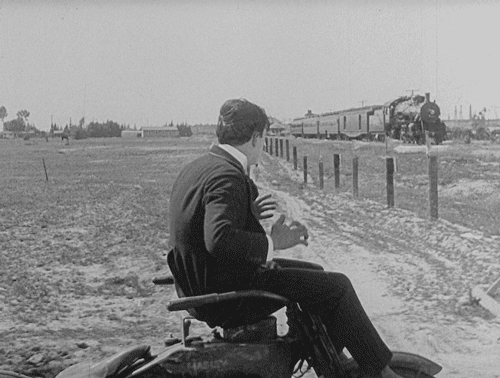 |
| TRAIN! |
Muito se debate sobre se Roscoe
Arbuckle trabalhou ou não como diretor neste filme. Roscoe e Buster eram bons amigos, e foi nos curtas de Arbuckle que Buster estreou no cinema. Buster nos
conta o que aconteceu de verdade no set de “Bancando o Águia” em sua
autobiografia “My Wonderful World of Slapstick”: Roscoe ainda era um pária por
causa do escândalo de Virginia Rappe alguns anos antes. Buster lhe ofereceu um
trabalho como diretor sob um pseudônimo. Entretanto, Roscoe era insuportável no
set. Sem autoconfiança e muito nervoso, ele fazia, segundo Buster, Kathryn
McGuire chorar doze vezes por dia. Buster então convenceu Marion Davies a
contratar Roscoe para dirigir o filme “O Moinho Vermelho” – e ela o fez,
deixando que Buster dirigisse “Bancando o Águia” sozinho.
It’s debated whether or not Roscoe
Arbuckle worked as a director in this film. Roscoe and Buster were good friends, and it was in Arbuckle’s shorts that Buster got his start in the
movies. Buster tells us what really happened on the set of “Sherlock Jr” in his
autobiography “My Wonderful World of Slapstick”: Roscoe was still a pariah due
to the Virginia Rappe scandal a few years before. Buster offered him a
directing job under a pseudonym. However, Roscoe was just irascible on set.
Without self-confidence and very nervous, he’d make, as Buster states, Kathryn
McGuire cry a dozen times a day. Buster then convinced Marion Davies to hire
Roscoe to direct her picture “The Red Mill” – which she did, and Buster alone
directed “Sherlock Jr”.
Assim como muitos outros, eu
adoraria se “Bancando o Águia” fosse mais longo – afinal, quando mais Buster
Keaton, melhor. Entretanto, este filme de 44 minutos consegue contar duas
histórias paralelas, apresentar muitas gags e, o mais importante, mostrar como o cinema pode ser ao mesmo
tempo escapismo e inspiração.
As I’m sure many others would, I’d love
if “Sherlock Jr” was longer – after all, the more Buster, the better. However,
this 44-minute film manages to tell two parallel stories, deliver a lot of gags
and, the most important, show how cinema
can be at the same time escapism and inspiration.
This is my contribution to the Sixth Annual Buster Keaton blogathon, hosted by Lea at Silent-ology.



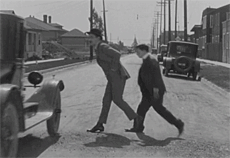
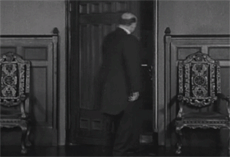

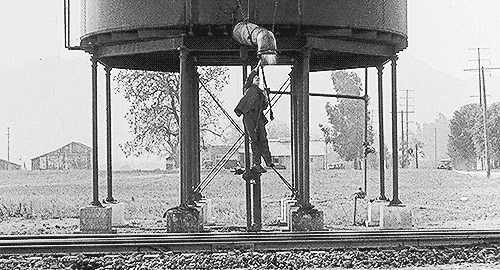
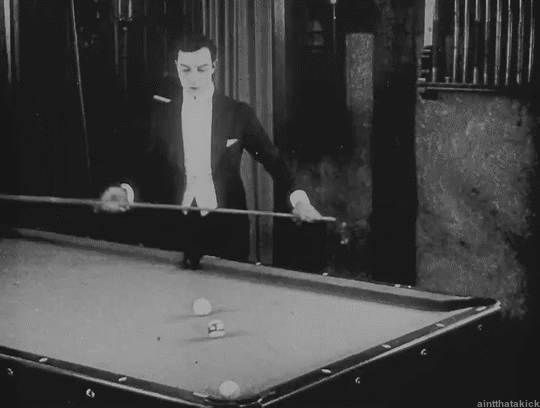
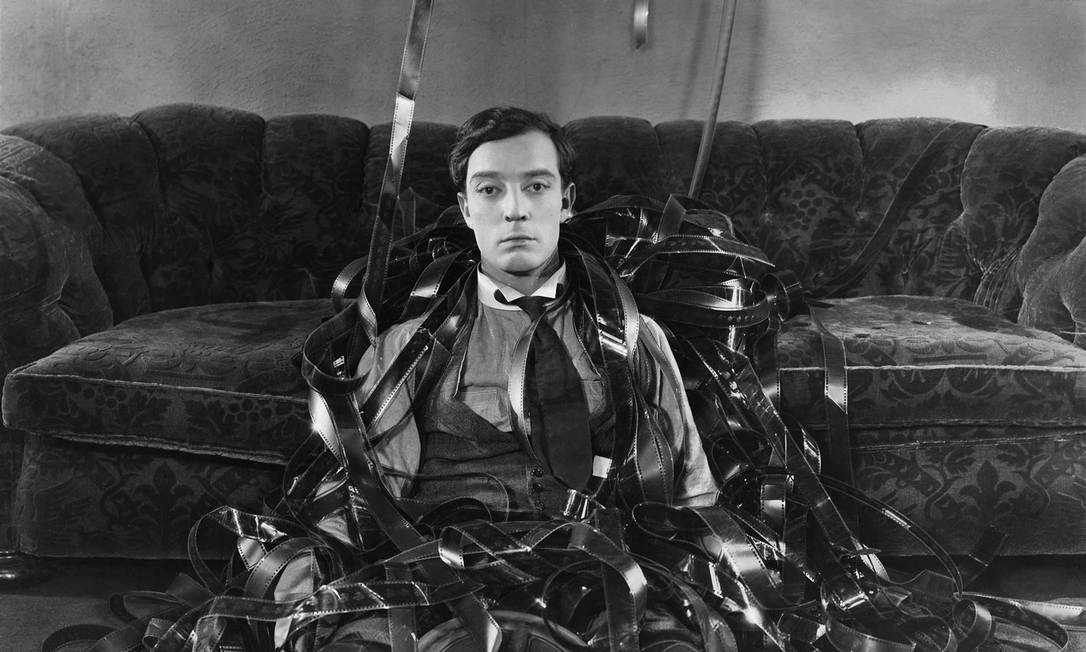

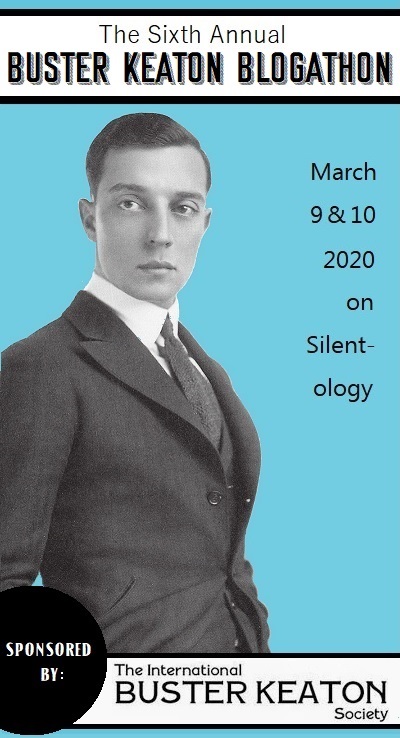
"Mise-en-abyme"--how the heck did I miss this term? I learned something new today, thank you! And thank you for covering this gem of a film for the blogathon, it's always nice to see it get some love.
ReplyDeleteI, too, am curious about how much Arbuckle contributed to the film...I don't suppose we can find out at this point, but you never know!
Hi Lê. That was a great reflection on Sherlock Jr. I don’t know if it come have been longer and kept its wonderful qualities. I agree with Lea, “Mise-en-any ever” is a new name to me. Thank you for sharing it with us.
ReplyDeleteThe term "ise-en-abyme" is new to me, too, although I really like this storytelling technique.
ReplyDeleteThis is one of my fave Buster Keaton films. Like you said, one wishes it could be longer, but we'll settle for 44 fabulous minutes.